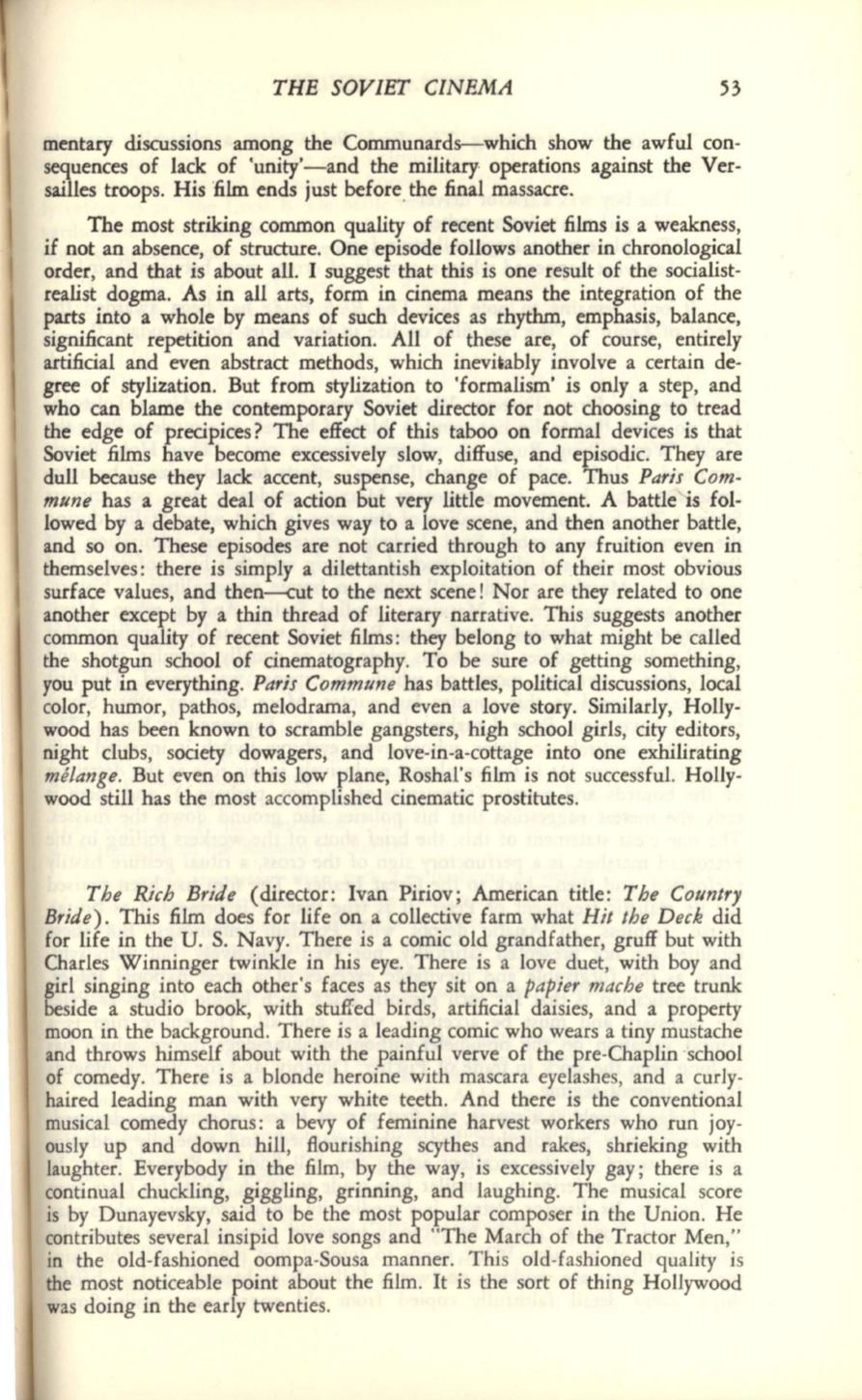
THE SOVIET CINEMA
53
mentary discussions among the Communards-which show the awful con–
sequences of lack of 'unity'-and the military operations against the Ver–
sailles troops. His 'film ends just before,the final massacre.
The most striking common quality of recent Soviet films is a weakness,
if not an absence, of structure. One episode follows another in chronological
order, and that is about all. I suggest that this is one result of the socialist–
realist dogma. As in all arts, form in cinema means the integration of the
parts into a whole by means of such devices as rhythm, emphasis, balance,
significant repetition and variation. All of these are, of course, entirely
artificial and even abstract methods, which inevitably involve a certain de–
gree of stylization. But from stylization to 'formalism' is only a step, and
who can blame the contemporary Soviet director for not choosing to tread
the edge of precipices? The effect of this taboo on formal devices is that
Soviet films have become excessively slow, diffuse, and episodic. They are
dull because they lack accent, suspense, change of pace. Thus
Paris Com–
mune
has a great deal of action but very little movement. A battle 'is fol–
lowed by a debate, which gives way to a love scene, and then another battle,
and so on. These episodes are not carried through to any fruition even in
themselves: there is simply a dilettantish exploitation of their most obvious
surface values, and then---<:ut to the next scene! Nor are they related to one
another except by a thin thread of literary narrative. This suggests another
common quality of recent Soviet films: they belong to what might be called
the shotgun school of cinematography. To be sure of getting something,
you put in everything.
Paris Commune
has battles, political discussions, local
color, humor, pathos, melodrama, and even a love story. Similarly, Holly–
wood has been known to scramble gangsters, high school girls, city editors,
night clubs, society dowagers, and love-in-a-cottage into one exhilirating
melange.
But even on this low plane, Roshal's film is not successful. Holly–
wood still has the most accomplished cinematic prostitutes.
The Rich Bride
(director: Ivan Piriov; American title:
The Country
Bride).
This film does for life on a collective farm what
Hit the Deck
did
for life in the U. S. Navy. There is a comic old grandfather, gruff but with
Charles Winninger twinkle in his eye. There is a love duet, with boy and
girl singing into each other's faces as they sit on a
papier mache
tree trunk
beside a studio brook, with stuffed birds, artificial daisies, and a property
moon in the background. There is a leading comic who wears a tiny mustache
and throws himself about with the painful verve of the pre-Chaplin school
of comedy. There is a blonde heroine with mascara eyelashes, and a curly–
haired leading man with very white teeth. And there is the conventional
musical comedy chorus: a bevy of feminine harvest workers who run joy–
ously up and down hill, flourishing scythes and rakes, shrieking with
laughter. Everybody in the film, by the way, is excessively gay; there is a
continual chuckling, giggling, grinning, and laughing. The musical score
is by Dunayevsky, said to be the most popular composer in the Union. He
contributes several insipid love songs and "The March of the Tractor Men,"
in the old-fashioned oompa-Sousa manner. This old-fashioned quality is
the most noticeable point about the film. It is the sort of thing Hollywood
was doing in the early twenties.


